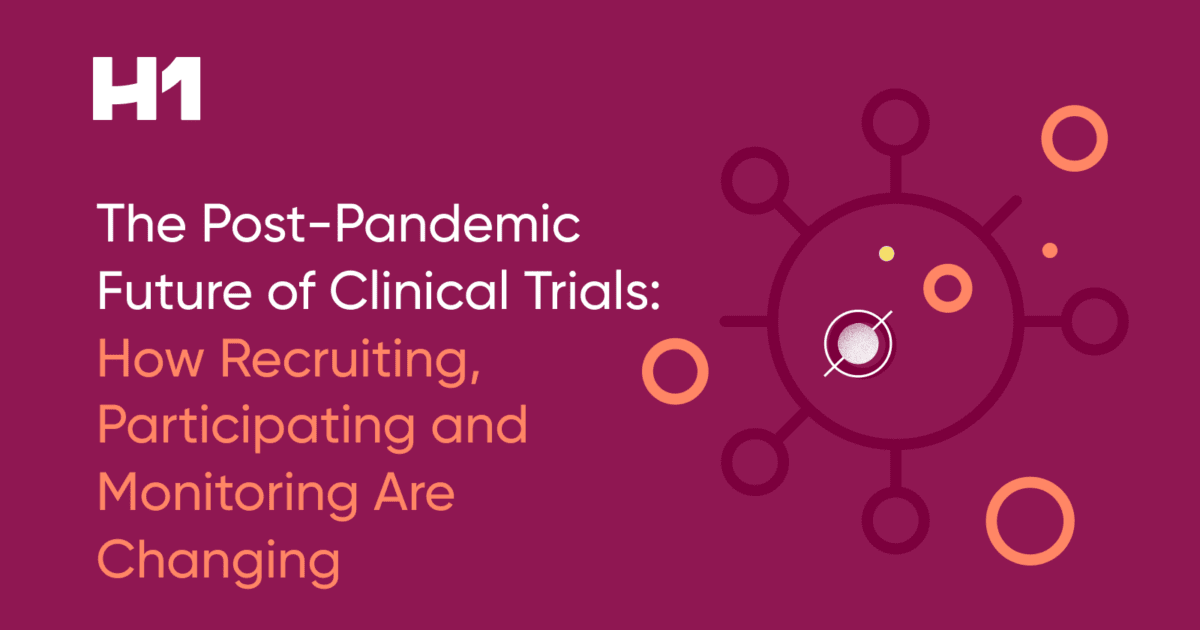The Post-Pandemic Future of Clinical Trials

How Recruiting, Participating & Monitoring Are Changing
In a post-COVID world, we’re seeing a decade’s worth of reshaping within clinical trials solidify in less than a year. While the life sciences industry was making a slow build toward decentralized clinical trials and broader inclusion, COVID-19 exposed gaps in reach and efficiency that can no longer be ignored. Moving forward, industry leaders are focused on modernizing and “opening up” the model for operating clinical trials in these three categories:
- Recruiting
- Participating
- Monitoring
For enterprises in the life sciences industry, the unprecedented challenge of adapting for pandemic-era patient interactions is eclipsed only by the rewards waiting on the other side. Firms stand to gain better results, fewer failed trials, better market reception and increased trust from physicians and patients. Patients stand to gain better, more effective devices and drug therapies that reflect the health needs of diverse populations.
From the Lab to the Home: How Institutions Are Designing COVID-Era Trials With Optimism
The biggest shift changing the landscape of clinical trials is the move from the lab to the home. During COVID-19, many hospitals and research institutions shifted from in-person clinical trials to home-based reporting. Unlike trial participants who have historically traveled to hospitals, medical offices or special clinics to participate in trials, 2020’s enrolled trial participants increasingly took part in decentralized testing that made the experience more accessible.
For decision-makers at life sciences and pharmaceutical firms, obvious questions about the integrity of remote and partially remote medical trials loom. First, it’s essential to look at what’s lost when enterprises aren’t able to adapt. During the first half of 2020, nearly 6,000 medical trials unrelated to the COVID-19 outbreak were stopped. During both pandemic and non-pandemic times, some obstacles for successful trials include:
- Enrollment challenges caused by an inability to recruit participants beyond “commuting distance” from a hospital or university.
- Lack of ability to stay faithful to established trial protocols requiring in-person contact.
- Lack of reliability for interventions and outcome assessments based on safety apprehensions among enrolled participants.
- Hesitancy among participants to enter hospitals.
- Restrictive hours for potential patients.
A successful, fully remote study evaluating whether fluvoxamine improved outcomes compared to placebo in 152 outpatients newly diagnosed with COVID-19 done out of St. Louis in 2020 shows that it’s possible to see studies through without any patient contact. For the study, eligibility was verified by phone and email. Next, researchers verified each COVID diagnosis using electronic health record reviews. Participants in this first-of-its-kind study performed self-assessments using equipment shipped to their homes with help from virtual and telephone conversations with researchers.
This successful remote trial wasn’t an anomaly. A survey of 245 clinical trial investigators revealed that remote interactions shot up from 9 percent in January of 2020 to 57 percent during May 2020. Survey participants cited remote activities as essential tools for facilitating trial progress during the pandemic. Tools used to support remote trials included:
- Physical activity monitors, pulse oximeters and other devices used to measure outcomes.
- Web/video interactions.
- Home visits.
- A pivot to outdoor visits for administering interventions and measuring outcomes.
In a recent Scientific American article, several high-profile researchers shared their optimism that a new openness to remote trials will help to push research forward. During the early months of COVID-19, MD Anderson Cancer Center in Houston shifted its participating enrollment and follow-up visits to phone and video. The need for safe communication served as a catalyst for the institution to modernize its patient interactions.
“The big thing that we had been dying to do for years was to establish remote consenting,” Jennifer Keating Litton told Scientific American when speaking of her experience of being president of clinical research during COVID-19. MD Anderson now allows patients to sign all consent forms online. There is similar optimism at AstraZeneca. In his role as head of oncology research, José Baselga sees the pandemic as being a catalyst for sweeping changes in cancer research. The researcher sees remote monitoring as a convenient and safer option that was long overdue.
“Instead of waiting for them to show up in the emergency room sick and in pain, we can intervene ahead of that,” Baselga shared with Scientific American. Baselga sees a significant benefit in pivoting to a reliance on remote monitoring. Monitoring of heart rate, respiration and other physical functions paired with self-reporting on things like symptoms and appetite by patients daily can create a more accurate assessment than the custom of doing lab work every three weeks.
Taking Cues From the Big Players in Pharma and Wellness
No company is reshaping the landscape of clinical trials like CVS. In 2021, CVS Health unveiled CVS Health Clinical Trial Services with the mission of making clinical trial research more accessible to all communities to improve health outcomes and enhance the effectiveness of clinical trials. While CVS Health is focused on COVID-19 management at the moment, the long-term goal of crossing into clinical trials is to include more of the population in the development of all medicines.
According to CVS Health, less than 4 percent of the U.S. population participants in clinical studies. CVS Health also cites that 80 percent of studies fail to meet deadlines for participant enrollment. More than 30 percent of study participants drop out before study completion. To attract and retain more diverse populations in future studies, CVS Health has taken on the initiative of creating a more efficient and convenient experience across the board.
At the center of the blueprint is more precise patient recruitment. CVS Health is working with various biopharmaceutical and tech companies to use analytics, marketing reach and community connections to inform more individuals about opportunities to participate in clinical trials. The second core tenet is better trial delivery using decentralized options for Phase III and Phase IV trials. This shift would see study participants engaging with clinical researchers either virtually or at CVS locations. Thirdly, CVS Health is pivoting away from focusing solely on making observations in controlled lab settings. The brand plans to use technology to use real-world evidence to test therapeutics and devices “out in the wild.” The world doesn’t have to wait to see if CVS Health’s ambitious plan will work. During the development of COVID-19 vaccines, CVS Health collaborated with the pharmaceutical industry to use its enhanced screening protocols and digital communications to engage more than 300,000 volunteers around the country, meeting the inclusion criteria for vaccine trials.
Final Thoughts on How COVID-19 Reshaped Medical Research Forever: Future Clinical Trials Will Be More Adaptable and Inclusive
For life sciences firms, there’s no such thing as being too adaptable right now. While COVID-19 is precipitating protocol adjustments, it’s becoming clear that the changes will outlast the pandemic. Unleashed from restrictive norms for recruiting and interacting with patients, researchers are finding ways to bring more people into trials by simply making enrollment and participation accessible beyond restraints like geography and availability during “business hours.” If the momentum can be maintained, the result will be fewer abandoned trials, greater trust of the life sciences industry and upgraded product development.
